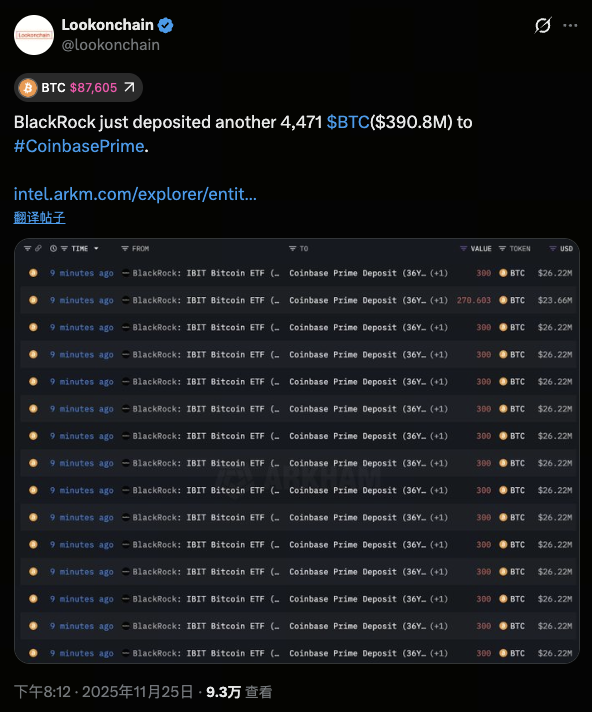BlackRock’s $400 Million Bitcoin Purchase Sparks Market Liquidity Concerns
BlackRock’s Ongoing Expansion in Crypto Assets
Over the last two years, BlackRock has steadily deepened its involvement in the cryptocurrency market. Since the approval of spot Bitcoin ETFs, BlackRock’s iShares Bitcoin Trust (IBIT) has emerged as one of the fastest-growing products in the sector. As the world’s largest asset manager, BlackRock’s decisions often set the tone for market sentiment.
From an institutional strategy standpoint, BlackRock has long considered Bitcoin a viable asset class for long-term allocation, holding a strategic position alongside gold, bonds, and equities. As a result, regardless of short-term market swings, BlackRock continues to expand its footprint in the crypto space.
The Implications Behind a $400 Million Bitcoin Transfer

Source: https://x.com/lookonchain/status/1993291699356155926
On November 25, 2025, BlackRock transferred over 4,471 Bitcoins—worth roughly $400 million—to its Coinbase Prime custody account. This move has fueled speculation about whether it was intended to rebalance ETF holdings, reserve liquidity for potential market volatility, or adjust portfolio positions.
No matter the underlying motive, asset transfers of this magnitude reflect an institution’s unique perspective on market trends. For individual investors, large-scale institutional rebalancing often signals early strategic positioning and warrants close attention.
Why Is the Market on Liquidity Alert?
This move by BlackRock is being called a liquidity alert for three key reasons:
1. Large Transfer Size and Noticeable Impact
Moving over 4,000 Bitcoins in one transaction is seen as a hedging or rebalancing action. Given Bitcoin’s limited spot liquidity, transfers of this scale often trigger price movements.
2. Coincides with Significant ETF Redemptions
IBIT recently experienced record outflows. As institutional capital exited the ETF, a major transfer occurred, raising questions about whether even larger rebalancing actions are underway.
3. Institutional Moves Seen as Market Trend Indicators
Investors often interpret BlackRock’s actions as signals of a looming market downturn, which can amplify panic and drive further liquidity tightening.
Bitcoin Price Volatility After the Event
Following the announcement, Bitcoin prices faced temporary downward pressure. Some traders believe the sudden drop in liquidity could lead to a test of support levels. Meanwhile, there was a marked shift in the long-short leverage ratio in the derivatives market, underscoring rising uncertainty about future price direction.
Still, Bitcoin’s long-term structural demand remains intact, with institutional buying showing resilience.
Potential Risks of Liquidity Tightening
If large-scale institutional rebalancing continues, several risks could emerge:
- Heightened short-term price swings: When liquidity is thin, trading thousands of Bitcoins can cause sharp price movements.
- Increased panic selling: Retail investors may misread the situation as “institutional exit,” leading to panic selling.
- Greater passive selling pressure from ETFs: Ongoing redemptions could force more Bitcoin sales.
- Risk of a negative feedback loop: Declining liquidity, falling prices, and further selling can trigger a chain reaction across the market.
How Should Investors Respond?
Given the current environment, investors should consider the following:
- Do not overanalyze a single institution’s actions
Major moves by institutions are usually part of broader strategies and don’t necessarily signal a bearish outlook. - Monitor ETF flows closely
Ongoing ETF inflows or outflows are critical indicators of market trends. - Avoid excessive leverage
High leverage is especially vulnerable during periods of tight liquidity. - Adopt medium-term and long-term strategies
If you believe in Bitcoin’s long-term value, periods characterized by market panic may present strategic entry points.
Related Articles

Pi Coin Transaction Guide: How to Transfer to Gate.com

Flare Crypto Explained: What Is Flare Network and Why It Matters in 2025

How to Use a Crypto Whale Tracker: Top Tool Recommendation for 2025 to Follow Whale Moves

2025 BTC Price Prediction: BTC Trend Forecast Based on Technical and Macroeconomic Data

What is N2: An AI-Driven Layer 2 Solution
